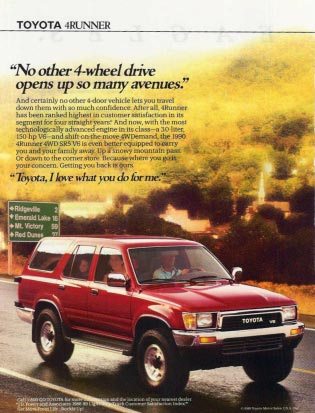|
Main Menu
|
|
|
|
4Runner History
|
|
|
|
Other
|
|
|
|
|
| 1990 4Runner History: |
The all-new, second-generation 4Runner premieres in mid-1989, as a 1990 model, based on the 1989 Pickup.
The following items have been changed in the 1990 models.
For the first time, 2-door and 4-door 2WD and 4WD models are available. Rear ABS is standard, but works only in 2WD.
Removable rear roof section disappears and an integrated steel body replaces the fiberglass rear shell,
making the vehicle quieter and more weather tight. Shift-on-the-fly 4WD is now optional.
Ride comfort improves with the addition of a 4-link, coil-spring rear suspension.
The Hi-Trac independent torsion bar front suspension is shared with the 4WD Toyota Truck.
Extensive up–grading of the interior by the use of full trim.
1. 3VZ–E Engine
The ordinary oxygen sensor, which used a zirconia element, is replaced with a new type oxygen sensor which uses
a titania element in the 2WD TRUCK model for California.
2. A340F Automatic Transmission
This transmission is an automatic transmission with transfer which has been developed for 4WD models equipped
with the 22R–E engine. The transmission portion is the same as the A340E automatic transmission and the transfer
portion is a planetary gear type as used in the R150F manual transmission. Each of these portions has undergone
changes and then has been combined to form the A340F automatic transmission.
3. Suspension
The connection between the stabilizer bar and the stabilizer link in the front suspension is changed
from a rubber cushion to a ball joint. This provides a smooth roll feeling with little delay in steering.
4. Brake
The rear–wheel anti–lock brake system is standard in models equipped with the 3VZ–FE engine and is available as
part of an option package with power steering in other models. This system is designed to minimize lock–up of the
rear wheels in sudden braking or braking on slipping surfaces to help you maintain direction control. The front brakes
are not controlled by the rear–wheel anti–lock brake system.
5. Daytime Running Light System
For Canada, a daytime running light system, which lights up the headlights and taillights during daylight hours, is
used to improve vehicle visibility from the outside during the daytime.

1990 |
|
|


